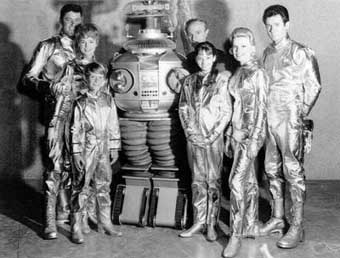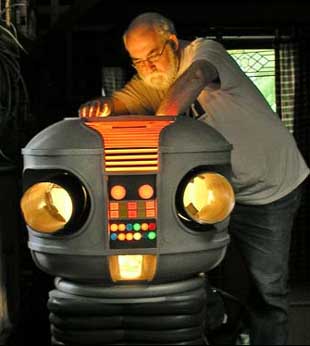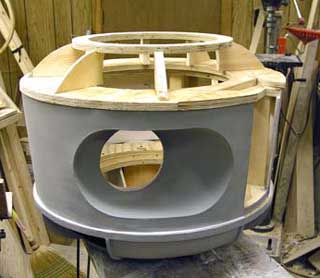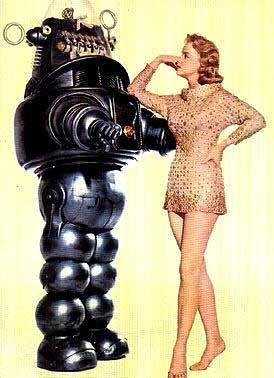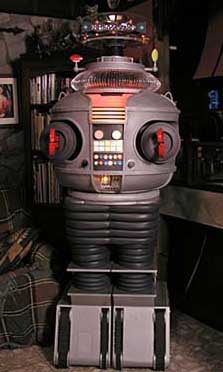pop up description layer
HOME
Cryptozoology UFO Mysteries Aviation Space & Time Dinosaurs Geology Archaeology Exploration 7 Wonders Surprising Science Troubled History Library Laboratory Attic Theater Store Index/Site Map Cyclorama
Search the Site: |
|
Notes from the Curator's Office: The B9 Builders Club
(9/06) One of the great things about the internet is that even if you have a fairly bizarre hobby or interest that maybe only one out of one hundred thousand people share with you, you can still find other people on the web with that same unusual interest or hobby. Why? Because with estimates of the number of people connected to the internet exceeding one billion, even if only one out of 100,000 individuals are into the same thing as you are, that still gives you 10,000 potential members of your interest group. Now, this can be a bad thing if your interest is something like being a terrorist and blowing up buildings. However, for people with slightly more tame hobbies, it's a great boon. This brings us to the B9 Builders Club. Now, you ask, what is a B9 and why would you want to build one? To answer that question we need to travel back to 1965 to a rather schlocky, but fun television show called Lost in Space (LIS to those in the know). It was one of several science fiction TV productions of that era produced by Irwin Allen (The others being Voyage to the Bottom of the Sea, Time Tunnel and Land of the Giants). The show had the Robinson family going to colonize another planet, traveling on a flying saucer shaped space ship called the Jupiter II. When enemy agent Dr. Zachary Smith tries to sabotage the flight, and gets trapped on board, his extra weight throws the ship off course and they become hopelessly lost, which is, of course, the premise of the series.
The Jupiter II's crew includes not only the
Robinson family, their pilot, Major West, and the wayward Dr.
Smith, but also an environmental control robot. During the series
the robot isn't really called anything much more than "robot."
However, some people have done research to show that the proper
name is the "B9."
There are a lot of people who grew up in that era, who watched the show as kids and really liked the robot. Despite its unimaginative name, it became one of the most endearing members of the cast. Many of the scripts surrounded the relationship between young Will Robinson (played by Bill Mummy), Dr. Smith (Jonathan Harris) and the B9 (Bob May with the voice of Dick Tufeld). Over the course of the series the robot turns from dull automaton to friend and protector of Will and foe of the slightly slimy Dr. Smith. Smith, in a running gag during the show, takes to continually insulting the B9, giving him such classic monikers as the "bubble-headed booby." Building the Bubble-Headed Booby What kid wouldn't want a B9 to pal around with? Polar Lights came out with a model kit that allowed you to construct an eight-inch-high replica of the B9. I built one as a kid and later bought another to build as an adult. For some people, though, that eight-inch model just isn't enough and only a full-sized version will suffice. That's where the B9 Builders Club comes into the picture. The club (http://www.b9robotbuildersclub.com/) dates from the late 90's and has gone through several revisions. Mainly, it is a place where people interested in building full-sized versions of the B9 can get advice, exchange ideas, buy or trade parts, and show off their creations. The club currently has almost 400 members, though it isn't clear how many of those people are finished building their full-sized replica, are actively working on one, or have gotten part-way through one that now sits in some dusty corner of the basement.
To get a better perspective on the organization, I decided to talk to Mike Joyce, who currently runs the club. Joyce who's a former Air Force pilot with a background in math and computer science. Like so many of the members, Joyce was a LIS fan and thought it would be fun to build a reproduction of the B9. "I've always built things as a hobby," he told me in an email. He apparently found that he liked this hobby so much he turned it into a business by acquiring the rights to build the robot from the current LIS owners. His company, B9 Creations, is working on producing one-hundred and fifty copies of the robot. The fully finished versions, in addition to having the blinking lights and turning antennas, are capable of rotating their torso, moving their arms, and speaking 500 lines of dialog recorded by Dick Turfeld who was the voice of the original robot on the show. The first batch of ten robots went to customers earlier this year. If you are interested in buying one of his B9's, head off to his site and put your name in. Just don't get your heart set on one. The reservation list for all one hundred and fifty is already filled. You'll only get a chance to buy one if someone changes his mind and drops off the list. From Parts or From Scratch? Joyce not only builds, but along with several other members, acts as a vendor for difficult-to-make parts. The robot's torso, because of its curving shape, is particularly hard to do by yourself and get right. A fiberglass version from one of the vendors makes it simpler but will cost you anywhere from $650 to $1000. Other parts available include a clear acrylic bubble to house the brain, rubber arms, claws, treads, legs, lights, hooks, etc. The fact that much of the robot can be bought significantly speeds up the process of putting one together, but considerably increases the price. Many of the members of the club take pride in being able to build their robots from scratch without spending money on parts. I was particularly taken by pictures of a B9 made by a gentleman named Lew Place. It looked as good to my eye as the professionally built B9's, but he used almost no vendor-supplied componets. I contacted Place and asked him if he was a big fan of the series. "Absolutely," he replied. "I lived it every week as an eight-year-old in 1965." And the robot? "I wanted one since I was a kid, then discovered others were building incredible replicas and thought I'd give it a shot."
Place decided to avoid vendor parts both to save money and as a construction challenge. Even given this restriction, he had his robot almost complete in just three months. He estimates he spent thirty-five hours a week working on it, however, something that raised a few eyebrows around the house. "Everybody thought I had gone off the deep end until they saw it all lit up and working. It now comes up in conversation at least twice a day." The most difficult part of the project was the torso, which he created using mat board and wood. The difficult curves he shaped by laying Bondo (a putty-type material used to repair dents in cars) over the surface and sanding until it was the right shape. "I still can't believe I pulled that one off with the materials I used," he notes. In the end he spent a total of $1000 to get his B9. The one part he couldn't fabricate on his own was the glass bubble for the head, which cost him around $300 from a vendor. Since then, however, he's spent hundreds of more hours and more money working on improvements. He's even building a second B9 for a friend, though this time he bought the torso from one of the parts suppliers. The B9's Older Brother Seeing all these people building these great replicas inspired me. Could I build a robot? To tell you the truth, as much as I like the B9, I'd much rather construct a different science fiction icon, Robby the Robot, from the 1956 film Forbidden Planet. Robby was actually in quite a few films and even appeared as a guest on Lost in Space where he tried to steal the hearts of the Robinson Family away from the B9. In the script this turns out to be a ruse, of course, to kidnap the family and sell them to aliens. Fortunately the B9 rescues the family by putting Robby out of action before he can carry out his dastardly plan.
If Robby and the B9 were portrayed in that episode as antagonists, it was certainly a case of sibling rivalry. The two are truly brothers as they were both designed by Hollywood art director Bob Kinoshita and have similar features, including glass bubbles to house their brains and neon lights that glow when they speak. If there is a club for B9 fans and builders there must surely be one for Robby, right? Well, unfortunately not. This seems strange. Even that upstart R2D2 has a builders club. Why not Robby? Does this mean that Robby fans are less rabid than B9 fans? To find out I decided to contact Fred "Robotman" Barton. Mr. Barton has been fascinated by movie robots since he was a kid and has fashioned a career around producing replicas and restoring some of the original robot props so they can go into museums or private collections. Currently he is the only person licensed by Warner to make full sized copies of Robby. Barton thinks that part of the problem is the complexity of building this particular automaton. "The B9 is much easier to build out of household items and Home Depot kind of parts than Robby, who has hundreds of machined parts and must be sculpted," noted Barton. "It is impossible to build Robby with pre-fab commercially available parts. Plus, there is a huge support system for B9 in the form of the club to help even the most inexperienced builder to assemble the bubble-headed booby. Without the club there would be little or no B9's in any form." Barton, who helped found an early version of the B9 club back in '97, tried to put together a support group for Robbie, too. "I sponsored a Robby builders club for a while in the 90's with Warner Brothers' permission. They have since pulled the plug on a builders forum, or kit/parts or any kind of club surrounding their property, i.e., Robby." According to Barton, Warner has plans for the robot and worries that having a club would devalue him. He is, after all, a star, something confirmed by his having his own entry in the Internet Movie Database. Well, at least it's nice to hear Warner has plans for my cybernetic hero. Perhaps hosting a late-night talk show?
So, if I want to build a replica of Robby I'm on my own. No plans, parts or advice from a club. Perhaps if I really want one I will have to plunk down the 16 grand or so to buy one from Barton's company. From my point of view it would be a sound investment, though I doubt my wife would agree. Join the Club Perhaps a better route would be to construct his younger brother, the B9. If I join the club, I can get lots of help and advice and even a break on the cost of vendor-bought parts. They can even put me in contact with Dick Turfeld, who (for a modest fee) will record my own personal messages for my robot to say. I can imagine the B9 sitting in my finished basement next to the 52" home theater system. What a great conversation piece to have around when I invite friends over to watch some old science fiction movies. Maybe I should head out to Home Depot and get some plywood and Bondo right now. Oops! Forgot. My wife reminded me I'd better go and work on finishing the basement first... Copyright Lee Krystek 2006. All Rights Reserved. |
|
Related Links |
|
{ama
zonbooks}
|



